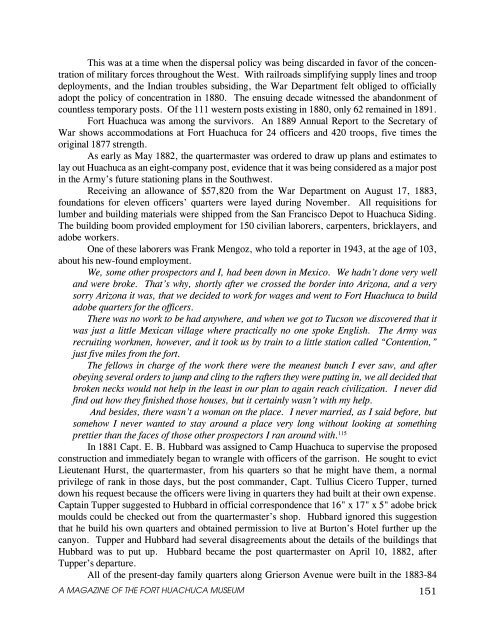Apache Campaigns - Fort Huachuca - U.S. Army
Apache Campaigns - Fort Huachuca - U.S. Army
Apache Campaigns - Fort Huachuca - U.S. Army
Create successful ePaper yourself
Turn your PDF publications into a flip-book with our unique Google optimized e-Paper software.
This was at a time when the dispersal policy was being discarded in favor of the concentration<br />
of military forces throughout the West. With railroads simplifying supply lines and troop<br />
deployments, and the Indian troubles subsiding, the War Department felt obliged to officially<br />
adopt the policy of concentration in 1880. The ensuing decade witnessed the abandonment of<br />
countless temporary posts. Of the 111 western posts existing in 1880, only 62 remained in 1891.<br />
<strong>Fort</strong> <strong>Huachuca</strong> was among the survivors. An 1889 Annual Report to the Secretary of<br />
War shows accommodations at <strong>Fort</strong> <strong>Huachuca</strong> for 24 officers and 420 troops, five times the<br />
original 1877 strength.<br />
As early as May 1882, the quartermaster was ordered to draw up plans and estimates to<br />
lay out <strong>Huachuca</strong> as an eight-company post, evidence that it was being considered as a major post<br />
in the <strong>Army</strong>’s future stationing plans in the Southwest.<br />
Receiving an allowance of $57,820 from the War Department on August 17, 1883,<br />
foundations for eleven officers’ quarters were layed during November. All requisitions for<br />
lumber and building materials were shipped from the San Francisco Depot to <strong>Huachuca</strong> Siding.<br />
The building boom provided employment for 150 civilian laborers, carpenters, bricklayers, and<br />
adobe workers.<br />
One of these laborers was Frank Mengoz, who told a reporter in 1943, at the age of 103,<br />
about his new-found employment.<br />
We, some other prospectors and I, had been down in Mexico. We hadn’t done very well<br />
and were broke. That’s why, shortly after we crossed the border into Arizona, and a very<br />
sorry Arizona it was, that we decided to work for wages and went to <strong>Fort</strong> <strong>Huachuca</strong> to build<br />
adobe quarters for the officers.<br />
There was no work to be had anywhere, and when we got to Tucson we discovered that it<br />
was just a little Mexican village where practically no one spoke English. The <strong>Army</strong> was<br />
recruiting workmen, however, and it took us by train to a little station called “Contention,”<br />
just five miles from the fort.<br />
The fellows in charge of the work there were the meanest bunch I ever saw, and after<br />
obeying several orders to jump and cling to the rafters they were putting in, we all decided that<br />
broken necks would not help in the least in our plan to again reach civilization. I never did<br />
find out how they finished those houses, but it certainly wasn’t with my help.<br />
And besides, there wasn’t a woman on the place. I never married, as I said before, but<br />
somehow I never wanted to stay around a place very long without looking at something<br />
prettier than the faces of those other prospectors I ran around with. 115<br />
In 1881 Capt. E. B. Hubbard was assigned to Camp <strong>Huachuca</strong> to supervise the proposed<br />
construction and immediately began to wrangle with officers of the garrison. He sought to evict<br />
Lieutenant Hurst, the quartermaster, from his quarters so that he might have them, a normal<br />
privilege of rank in those days, but the post commander, Capt. Tullius Cicero Tupper, turned<br />
down his request because the officers were living in quarters they had built at their own expense.<br />
Captain Tupper suggested to Hubbard in official correspondence that 16" x 17" x 5" adobe brick<br />
moulds could be checked out from the quartermaster’s shop. Hubbard ignored this suggestion<br />
that he build his own quarters and obtained permission to live at Burton’s Hotel further up the<br />
canyon. Tupper and Hubbard had several disagreements about the details of the buildings that<br />
Hubbard was to put up. Hubbard became the post quartermaster on April 10, 1882, after<br />
Tupper’s departure.<br />
All of the present-day family quarters along Grierson Avenue were built in the 1883-84<br />
A MAGAZINE OF THE FORT HUACHUCA MUSEUM<br />
151

















